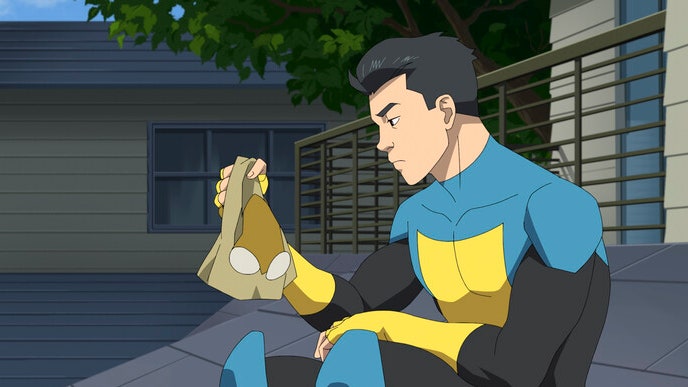In addition to Oh, who navigates Debbie’s newfound grief with expected gravitas, there’s Zazie Beetz, Andrew Rannells, Gillian Jacobs, Walton Goggins, Mark Hamill, Zachary Quinto, Jason Mantzoukas, Seth Rogen, and Sterling K. Brown, among many others. (Seriously, go look at this cast.) What’s unique about this talented collection of actors is the lack of vocal overlap—each superhero, villain, and ordinary citizen has a distinct sound and personality, which helps keep the show’s dozens of characters straight. The luxury of their familiar intonations and inflections makes even the smallest scenes crackle.
Invincible plays with music, art, and form in cinematic ways
At the beginning of Season 2’s first episode, Mark soars over the city and continues his superheroic duties in a montage set to Radiohead’s “Karma Police.” It’s an ideal, melancholic mood-setter, showcasing both Invincible’s ho-hum crime-fighting and his life-saving abilities as he grapples with his identity and his father’s duplicity.
The sequence lasts three minutes, but it embodies the best of this series: pointed musical cues, emotionally-driven storytelling, crisply painted metropolitan landscapes, and playful formatting. Over Thom Yorke’s familiar serenade, Mark experiences flashbacks to his father’s betrayal, painful memories that fuel his heroism and toss out unnecessary explication that animated shows often lean on. The clean aesthetic only underscores the chaotic and crimson color palette that emerges during his villainous showdowns.
Throughout the next few episodes, showrunner Simon Racioppa experiments even more with structure, at one point devoting a 15-minute section to Allen the Alien (Rogen). Using a radio teleplay-style narrator, we’re introduced to Allen’s origin story and his love interest, and we discover another betrayal that will have implications for Mark down the road. The credits roll halfway through the episode, which pivots back to its primary storyline for another 20 minutes. It’s slightly disorienting—but it’s thrilling to watch an animated show take these kinds of narrative risks.
The violence is exaggerated to an extreme, but it always serves a purpose.
As much as the new age of visual effects has allowed live-action movies to mimic action-packed comic panels, the MCU—like most of the superhero-movie category as a whole—still plays in the PG-13 sandbox. Invincible has no such restrictions. It revels in stylized violence that underlines the sheer force and otherworldly nature of its superhuman characters. The blood erupts like a stringy goo, and the killshots rival Mortal Kombat knockouts. Eyeballs burst from sockets, torsos get disemboweled. It’s bleak, cringe-worthy stuff.



